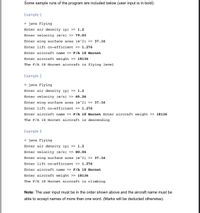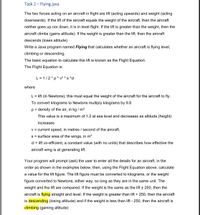
Database System Concepts
7th Edition
ISBN: 9780078022159
Author: Abraham Silberschatz Professor, Henry F. Korth, S. Sudarshan
Publisher: McGraw-Hill Education
expand_more
expand_more
format_list_bulleted
Concept explainers
Question
I want the full output in a picture 3 examples

Transcribed Image Text:Some sample runs of the program are included below (user input is in bold):
Example 1
> java Flying
Enter air density (p) » 1.2
Enter velocity (m/s) » 79.03
Enter wing surface area (m^2) >> 37.16
Enter lift co-efficient >> 1.276
Enter aircraft name >> F/A 18 Hornet
Enter aircraft weight >> 18136
The F/A 18 Hornet aircraft is flying level
Example 2
> java Flying
Enter air density (p) >> 1.2
Enter velocity (m/s) >> 65.26
Enter wing surface area (m^2) >> 37.16
Enter lift co-efficient >> 1.276
Enter aircraft name >> F/A 18 Hornet Enter aircraft weight >> 18136
The F/A 18 Hornet aircraft is descending
Example 3
> java Flying
Enter air density (p) >> 1.2
Enter velocity (m/s) >> 80.04
Enter wing surface area (m^2) >> 37.16
Enter lift co-efficient >> 1.276
Enter aircraft name >> F/A 18 Hornet
Enter aircraft weight >> 18136
The F/A 18 Hornet aircraft is climbing
Note: The user input must be in the order shown above and the aircraft name must be
able to accept names of more than one word. (Marks will be deducted otherwise).

Transcribed Image Text:Task 2 - Flying.java
The two forces acting on an aircraft in flight are lift (acting upwards) and weight (acting
downwards). If the lift of the aircraft equals the weight of the aircraft, then the aircraft
neither goes up nor down, it is in level flight. If the lift is greater than the weight, then the
aircraft climbs (gains altitude). If the weight is greater than the lift, then the aircraft
descends (loses altitude)
Write a Java program named Flying that calculates whether an aircraft is flying level,
climbing or descending.
The basic equation to calculate this lift is known as the Flight Equation.
The Flight Equation is:
L = 1/2*p* v² * s *cl
where
L = lift (in Newtons), this must equal the weight of the aircraft for the aircraft to fly.
To convert kilograms to Newtons multiply kilograms by 9.8
p = density of the air, in kg / m3
This value is a maximum of 1.2 at sea level and decreases as altitude (height)
increases
v = current speed, in metres / second of the aircraft.
s = surface area of the wings, in m?
cl = lift co-efficient, a constant value (with no units) that describes how effective the
aircraft wing is at generating lift.
Your program will prompt (ask) the user to enter all the details for an aircraft, in the
order as shown in the examples below, then, using the Flight Equation above, calculate
a value for the lift figure. The lift figure must be converted to kilograms, or the weight
figure converted to Newtons, either way, so long as they are in the same unit. The
weight and the lift are compared. If the weight is the same as the lift + 250, then the
aircraft is flying straight and level. If the weight is greater than lift + 250, then the aircraft
is descending (losing altitude) and if the weight is less than lift - 250, then the aircraft is
climbing (gaining altitude)
Expert Solution
This question has been solved!
Explore an expertly crafted, step-by-step solution for a thorough understanding of key concepts.
Step by stepSolved in 4 steps with 4 images

Knowledge Booster
Learn more about
Need a deep-dive on the concept behind this application? Look no further. Learn more about this topic, computer-science and related others by exploring similar questions and additional content below.Similar questions
- Use Matlab to Plot the graph shown in image 2 using data in table on image 1, BMI= W*H Where W is the weight in kilograms and H is the height in meters. Or the four color curves, use the line width ‘3’. To display a BMI of a person use the following: circular MarkSize ‘8’, MarkerEdgeColor ‘cyan’. To display this you have to enter two values. these are the Height in meters and Weight in kilograms. And inform the outcome results to the person from the command window.arrow_forwardneed help/explanation of how to do this. see image below i tried writing something down for lines 7-9 but I'm really stuckarrow_forwardWrite a MATLAB code to: 1-Read the 'kids.tif' and 'cameraman.tif 2-Resize the two images to be [200,200]. 3- Create an image Z have summation of the above two images. 4-Display the above images in 1,2 and 3 in the same figure.arrow_forward
- Q2: Write a Matlab Program to print out the multiplication table (1-12) (using loops)arrow_forwardLAB L 4 part 2 T NewR-10 AAA E EE ACD ACaDx AaBb BIU-X, x A-7-A. IIS.A-- t Painter 1Nomal 1No Spec Heading1 Hea Stym .. 2 Write a MATLAB program that find the sum of first 20 numbers (only even number) by using 1. for loop 2. while loop O YouTube DOLLarrow_forward
arrow_back_ios
arrow_forward_ios
Recommended textbooks for you
 Database System ConceptsComputer ScienceISBN:9780078022159Author:Abraham Silberschatz Professor, Henry F. Korth, S. SudarshanPublisher:McGraw-Hill Education
Database System ConceptsComputer ScienceISBN:9780078022159Author:Abraham Silberschatz Professor, Henry F. Korth, S. SudarshanPublisher:McGraw-Hill Education Starting Out with Python (4th Edition)Computer ScienceISBN:9780134444321Author:Tony GaddisPublisher:PEARSON
Starting Out with Python (4th Edition)Computer ScienceISBN:9780134444321Author:Tony GaddisPublisher:PEARSON Digital Fundamentals (11th Edition)Computer ScienceISBN:9780132737968Author:Thomas L. FloydPublisher:PEARSON
Digital Fundamentals (11th Edition)Computer ScienceISBN:9780132737968Author:Thomas L. FloydPublisher:PEARSON C How to Program (8th Edition)Computer ScienceISBN:9780133976892Author:Paul J. Deitel, Harvey DeitelPublisher:PEARSON
C How to Program (8th Edition)Computer ScienceISBN:9780133976892Author:Paul J. Deitel, Harvey DeitelPublisher:PEARSON Database Systems: Design, Implementation, & Manag...Computer ScienceISBN:9781337627900Author:Carlos Coronel, Steven MorrisPublisher:Cengage Learning
Database Systems: Design, Implementation, & Manag...Computer ScienceISBN:9781337627900Author:Carlos Coronel, Steven MorrisPublisher:Cengage Learning Programmable Logic ControllersComputer ScienceISBN:9780073373843Author:Frank D. PetruzellaPublisher:McGraw-Hill Education
Programmable Logic ControllersComputer ScienceISBN:9780073373843Author:Frank D. PetruzellaPublisher:McGraw-Hill Education

Database System Concepts
Computer Science
ISBN:9780078022159
Author:Abraham Silberschatz Professor, Henry F. Korth, S. Sudarshan
Publisher:McGraw-Hill Education

Starting Out with Python (4th Edition)
Computer Science
ISBN:9780134444321
Author:Tony Gaddis
Publisher:PEARSON

Digital Fundamentals (11th Edition)
Computer Science
ISBN:9780132737968
Author:Thomas L. Floyd
Publisher:PEARSON

C How to Program (8th Edition)
Computer Science
ISBN:9780133976892
Author:Paul J. Deitel, Harvey Deitel
Publisher:PEARSON

Database Systems: Design, Implementation, & Manag...
Computer Science
ISBN:9781337627900
Author:Carlos Coronel, Steven Morris
Publisher:Cengage Learning

Programmable Logic Controllers
Computer Science
ISBN:9780073373843
Author:Frank D. Petruzella
Publisher:McGraw-Hill Education